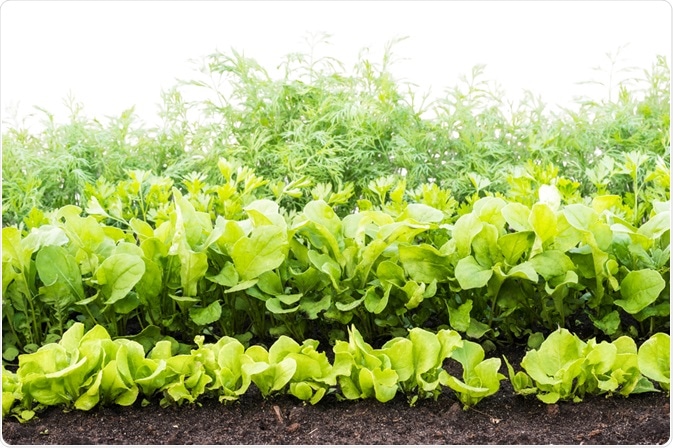Why nitrogen is essential for crops
Nitrogen is essential to support the development of healthy crops.

Image Credit: Efimova Anna/Shutterstock.com
On average, plant tissues exposed above ground contain around 3-4% nitrogen, which is a significantly higher concentration than levels of other nutrients.
Carbon, oxygen, and hydrogen are present in higher concentrations; however, these elements do not usually influence soil fertility management programs.
The reason that nitrogen is so important to crop growth is that it helps form chlorophyll, the substance that supports the process of photosynthesis.
Also, it helps form essential amino acids that have many important roles in the growth of plants, such as providing the structural units or acting as enzymes.
In addition, nitrogen is also a vital component of ATP which allows cells to conserve energy, as well as a vital component of nucleic acids such as DNA.
Therefore, nitrogen content in soil is fundamentally important for ensuring the growth of healthy crops. However, not all crops need the same amount, and providing enough nitrogen is also just as important as ensuring nitrogen concentrations in soil are not superfluous.
This can lead to contamination of groundwater through leaching of nitrogen in the soil, or via rainwater runoff.
A robust, cost-effective, and reliable test is therefore needed to allow those working with crops to obtain levels of nitrogen in their soil, allowing them to both grow healthy crops, and prevent the detrimental impact on the environment related to excessive nitrogen content.
How to measure nitrogen in soil
For several years there have been many testing methods available to researchers and agricultural scientists to determine the levels of nitrogen within the soil, such as Duma’s combustion, however, a truly reliable method of predicting nitrogen fertilizer application rates to optimize the yield of produce has remained elusive.
To overcome this lack of a reliable method, a team of researchers at North Carolina State University developed a new process whereby nitrogen levels in the soil are obtained by measuring biological activity within the soil.
The team had been inspired by the problem facing corn grain farmers. Around 1.2 pounds of nitrogen is required for each healthy bushel grown, but just applying this amount of nitrogen to the soil is not an accurate method, as it does not take into account the soil’s ability to mineralize nitrogen from organic matter, which varies between soil types.
A series of experiments were conducted to establish a new method of nitrogen measurement. First, it was demonstrated that nitrogen mineralization in the soil could reliably be determined with a three-day analysis of soil-test biological activity (STBA).
This test is useful because it measures the fauna, such as bacteria, insects, and fungi, that live in the soil and affect its nitrogen content.
Next, tests were conducted to establish whether higher levels of STBA did correlate with levels of nitrogen uptake in plants. The results showed that greater STBA was a reliable indicator of this activity.
Finally, a total of 47 farmer’s fields were tested for STBA. The researchers applied different levels of nitrogen fertilizer to these fields and found that those fields with higher STBA levels required lower levels of additional nitrogen to produce healthy crops.
Summary
The team was able to develop a simple and cost-effective method of measuring nitrogen levels within the soil through measuring levels of STBA.
These levels were then shown to be indicative of how much additional nitrogen, through nitrogen fertilizer, was optimal to ensure the growth of healthy crops, while protecting the environment for the harmful effects of excessive nitrogen.
The process that has been described here will likely be widely adopted to optimize crop-yield and reduce the environmental damage caused by agriculture, once the variations of N acquisitions due to edaphic and environmental factors have been extensively studied.
Sources:
- Balkcom, K., Blackmer, A., Hansen, D., Morris, T., and Mallarino, A. (2003). Testing Soils and Cornstalks to Evaluate Nitrogen Management on the Watershed Scale. Journal of Environmental Quality, 32(3), pp.1015-1024. https://acsess.onlinelibrary.wiley.com/doi/abs/10.2134/jeq2003.1015
- Franzluebbers, A. (2016). Should Soil Testing Services Measure Soil Biological Activity?. Agricultural & Environmental Letters, 1(1), p.150009. pdfs.semanticscholar.org/7bc3/1f29059e6e23487d601f3ca438493d9d831f.pdf
- Franzluebbers, A., Pershing, M., Crozier, C., Osmond, D. and Schroeder-Moreno, M. (2018). Soil-Test Biological Activity with the Flush of CO2: I. C and N Characteristics of Soils in Corn Production. Soil Science Society of America Journal, 82(3), pp.685-695. https://dl.sciencesocieties.org/publications/sssaj/articles/82/3/685
- Shah Jahan Leghari Niaz Ahmed Wahocho, Ghulam Mustafa Laghari, Abdul HafeezLaghari, Ghulam MustafaBhabham, Khalid HussainTalpur, Tofique Ahmed Bhutto,2Safdar Ali Wahocho, Ayaz Ahmed Lashari Role of Nitrogen for Plant Growth and Development: A Review. Advances in Environmental Biology 2016, 10(9) pp. 209-218
Further Reading